Apollon, à peine né sur l'îlot de Délos, part sur les routes pour trouver un lieu ou fonder son culte.
Après avoir été berné par la muse Telphousa qui cherche à l'écarter de son sanctuaire en Béotie, il prend le chemin du Parnasse pour y batir un temple. Il commence par tuer le monstre femelle qui gardait l'endroit. Le monstre pourrit, donnant son nom au lieu : Pythô.
Il détourne un groupe de navigateurs crétois pour qu'ils instaurent son culte en cet endroit.
L'Hymne homérique à Apollon : récit détaillé du voyage du dieu de Délos, son lieu de naissance, jusqu’à Delphes ...
Plusieurs variantes, contradictoires, coexistent sur la façon dont Apollon s'empara de l'oracle.
Certaines en donnent une version violente, d'autres laissent entendre que Thémis, à qui Gâ avait confié l'oracle, transmit paisiblement la propriété à Apollon.
Ces mythes sont à l'image du dieu, qui a une réputation a priori pacifique (civilisateur, constructeur, protecteur des troupeaux, musicien, etc.), mais dont une face mois connue est violente, sanguinaire ("l'Apollon au couteau"), et fut pour cette raison le dieu consulté par les meurtriers.
(écouter Marcel Détienne : Apollon, le bel assassin de Delphes)
En tout état de cause, Apollon a délogé une déesse qui régnait auparavant sur l'oracle. Gâ, Athéna, Déméter, Artémis étaient toujours vénérées à Delphes, mais, à part Gâ, ces déesses furent mises à distance de l'Apollonion, autour du temple, réservé au dieu principal.
DELPHES
nombril du monde grec
DELPHI
navel of the Greek World
Sanctuaire d'Athéna Pronaia
moderne "Marmaria"
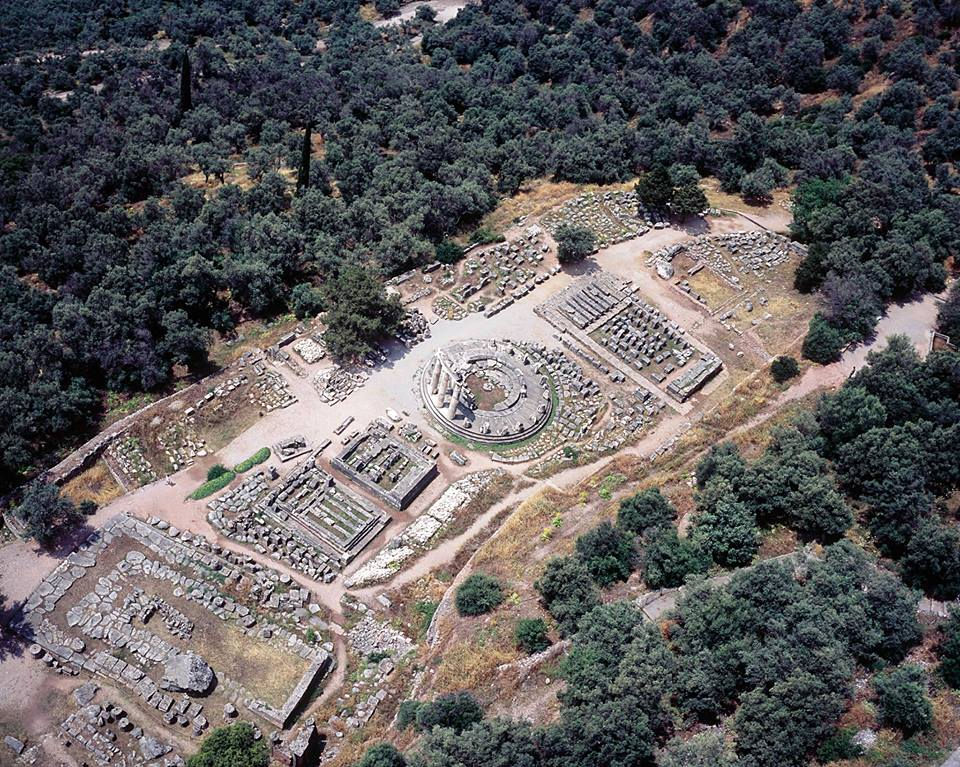
Sanctuary of Athena Pronaia
"Marmaria"

La terrasse appelée "Marmaria" à l'époque moderne fut fouillée dès 1838 par l'architecte allemand Laurent, et on y reconnu le sanctuaire d'Athéna décrit par Pausanias et d'autres auteurs anciens. La fouille reprit en 1901, à la suite de celle du sanctuaire principal et du gymnase.
Tout de suite apparurent des problèmes entre les informations fournies par ces auteurs et les vestiges mis au jour.
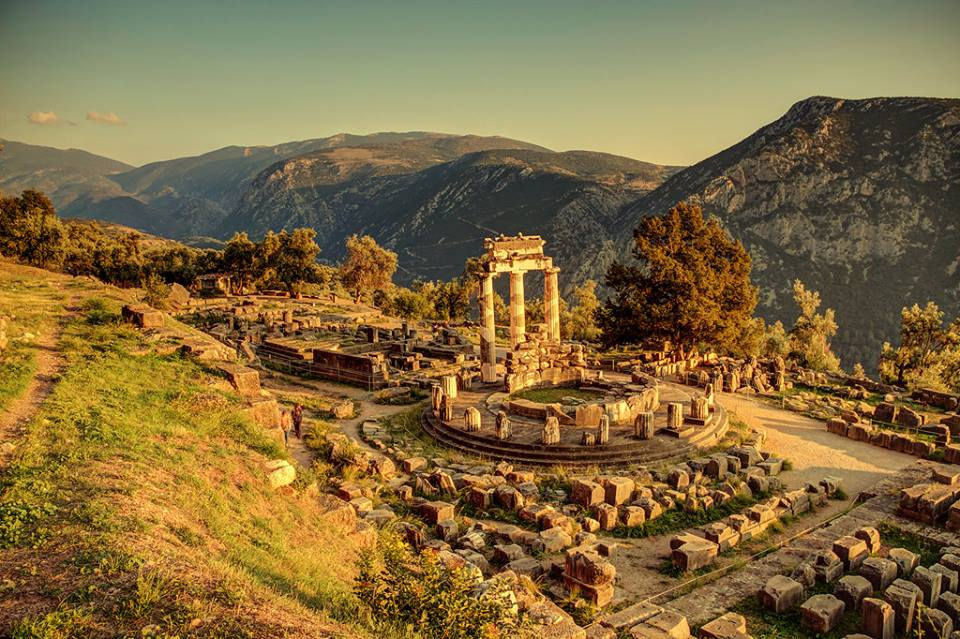
The terrace called "Marmaria" in modern times was excavated in 1838 by the German architect Laurent, then the sanctuary of Athena Pronaia described by Pausanias and other ancient authors was recognised. The excavation was resumed in 1901, following that of the main sanctuary and of the gymnasium.
Immediately problems arose between the information provided by these authors and the remains that were found.

Plan de Marmaria dressé après les fouilles
(Replat, Keramopoullos)
Map of Marmaria drawn up after the excavations
(Replat, Keramopoullos)
Restitutions du sanctuaire d'Athéna par Claude Golvin, 1996.
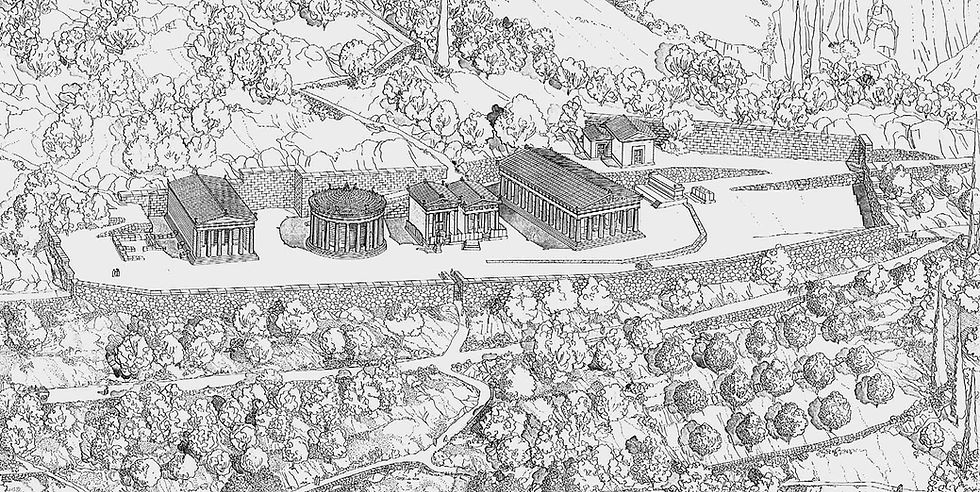
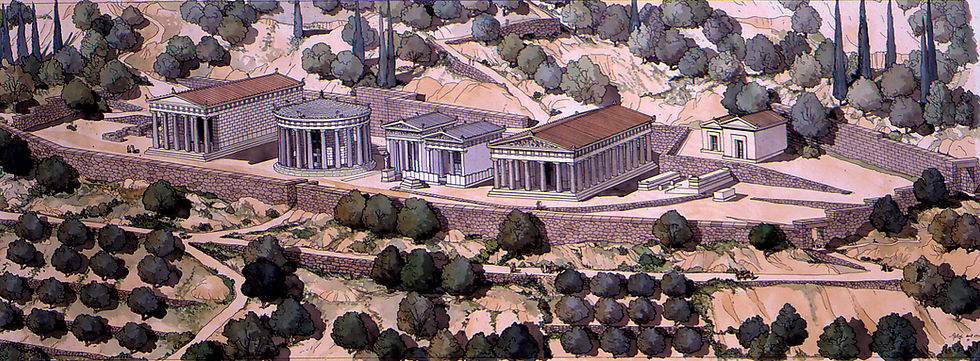
Ces problèmes d'interprétation des monuments ont reçu le nom d' "énigmes de Marmaria" et ont conduit à une littérature abondante, sans qu'aucune des nombreuses solutions proposées n'ait jusqu'à présent réussi à faire consensus.
These problems of interpretation of the monuments have been given the name of "enigmas of Marmaria" and have led to an abundant literature, without any of the many solutions having succeeded so far in reaching a consensus.
En 1996, une nouvelle étude fut entreprise, avec l'aide du Mécénat technologique et scientifique d'EDF, sur l'ensemble des monuments, qui permit de faire des progrès, mais sans résoudre les principaux problèmes restés en suspens.
Cette étude, ayant amplement recours à l'informatique, avait pour but de montrer le renouvellement des méthodes de travail généré par l'ordinateur.
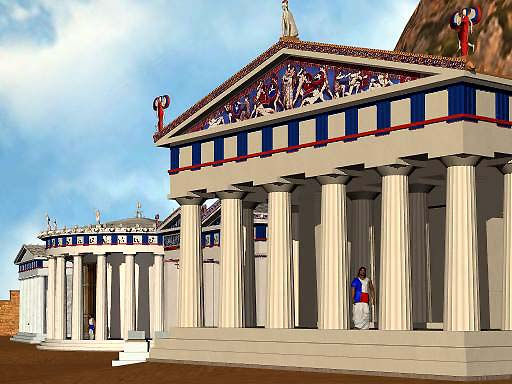
In 1996, a new study was undertaken, with the help of EDF's Mécénat technologique et scientifique, on all the monuments, which made it possible to make progress, but without resolving the main problems that remained unresolved.
The aim of this study, which made extensive use of numeric technology, was to show the renewal of working methods generated by the computer.

Une des causes des difficulté rencontrées est le peu d'informations fournies par Pausanias sur la "série de temples que l'on trouve en rentrant dans la ville". Aucune inscription ne permet d'identifier sûrement les bâtiments de la terrasse, donc de nombreuses possibilités de lecture du texte et d'identifications des bâtiments sont possibles.
One of the causes of the difficulties encountered is the scant information provided by Pausanias on the "series of temples to be found on entering the city". There are no inscriptions that clearly identify the buildings on the terrace, so there are many possible ways of reading the text and identifying the buildings.